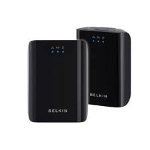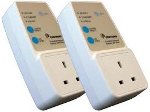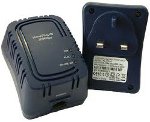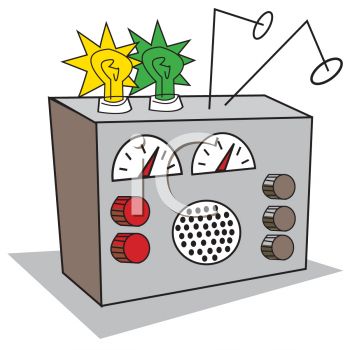What is Power Line Technology?
What is PLT?
It has many names and acronyms, so let us bring you up to speed: PLT can mean both Power Line Telecommunications and Power Line Technology; and it is often referred to as Power Line Adapters (PLA). It is a form of Power Line Communication and it takes the shape of devices which you can plug into a standard mains outlet socket for the purposes of running an Ethernet computer network around your property. It is a "self-install" system designed to negate the need to install proper computer data networking (Cat 5E), which usually requires considerable effort and the skills of an electrician to route cables through walls and floor voids (although this is a one-off hassle). It is also sold as a replacement for Wi-Fi for those who experience over-crowded Wi-Fi channels in their locale; although this seems rather self-defeating?!
Here are some images of the typical PLA devices causing the trouble:
 |
 |
 |
 |
PLAs are manufactured against two competing industry "standards": The HomePlug Power Alliance (HPA) and the Universal Powerline Association (UPA). The two technologies are of course not compatible and they both use different techniques to transmit the signal around your home's mains wiring.
Do not be confused with the term Broadband over Power Line (BPL). BPL is a system whereby the local electricity company attempts to send broadband signals along the mains supply to your property for the purposes of providing Internet connectivity. To date, the vast majority of BPL deployments have been shutdown as commercial flops; they were too slow and generated too much interference.
PLT devices have been available from a number of outlets for several years, but the "technology" is poorly thought out and poorly implemented and throughput speeds are quite poor compared to Wi-Fi or hard-wired networking using Category 5 UTP or Category 6 UTP data cabling (both of which are capable of 1Gbps). The number of installed units suddenly increased when BT Vision launched its IPTV over Broadband package to home users. Instead of offering users a crash-course in networking, they chose to include a set of Comtrend PG902 PLT devices for end-user self-installation. This has greatly increased the number of PLT devices in use by an un-aware public!
Powerline networking (PLT) is an unethical technology which causes serious problems for radiocommunications. Despite the non-compliant nature of the technology with established internationally agreed limits for interference, the European Commission has permitted the industry to continue with impunity to the EMC Directive, leading to speculation of corruption within the Commission itself.
EMC experts, organisations, radio users and enthusiasts have tried hard to have their respective national administrations see sense. However in Europe, it has become clear that the Regulators are being directed by the EC's "no barrier to free-trade" mantra, which is used to ensure the non-compliant technology remains on the open market.
These devices have spent the last few years destroying the HF radio spectrum, much to the annoyance of Shortwave Radio listeners, Radio Amateurs and Citizens' Band radio users. Not content with that, a new breed of PLT is now available which wipes out VHF as well. You can kiss goodbye to your FM stereo, DAB, business radio, taxi radio, Air Traffic Control and more...
How does PLT "work"?
Power Line Adapters transmit their signal over the in-house mains wiring by injecting a very high level of radio frequency energy on to the phase (live) and neutral wires. They use a wide-band modulation method known as Orthogonal Frequency Division Multiplexing (OFDM) to encode the Ethernet frames into a radio signal. PLA manufacturers believe this signal happily travels along the mains wiring within the house and does not pass through the electricity meter or radiate from the cables. This sadly is a fundamental mis-understanding of how radio signals operate! The mains wiring in your property was designed for one thing and one thing only: mains electricity! It was not designed to handle radio energy. For that we have co-axial cable; used to connect TV/Satellite aerials (for example). And for networking, we have Category 5 UTP and Category 6 UTP, a balanced cable designed to handle high-frequency signals used by Ethernet networking. So, if you are operating a pair (or more) of PLT devices, your mains wiring is leaking radio energy like a sieve! Your PLT signals are also winding their way along the phase and neutral conductors leaving your property. UK domestic 3-phase wiring methods mean those neighbours who share the same power phase will see your PLT signals conducted on to their mains wiring. The same phase may also supply a lamp post, meaning your PLT noise will be radiated from there as well!
If you live in a village with over-head power cables and over-head telephone cables you will suffer a reduction in ADSL sync and throughput speeds. The PLT signals radiate from the mains and are coupled into the telephone lines via electromagnetic induction. This will not just affect your ADSL signal, but several properties in the local area. Your neighbours will be none too pleased to learn of this fact!
It has also been reported that the new breed of 1Gbps PLT (using frequencies up to 300MHz) cause considerable interference to the new VDSL system BT Openreach are installing to homes as part of their next-generation "broadband" offering. Yes that is right, BT Vision are shipping a product which wrecks what BT Openreach are rolling out!
The Orthogonal Frequency Division Multiplex modulation technique creates a swathe of noise across the radio spectrum running from 2 to 30MHz (in the case of the early HPA/UPA devices) and up to 300MHz in the case of the new 1Gbps devices now being sold. This radio energy leaking from the home of a PLT user can radiate in all directions up to 500 metres and further. When viewed at the level of a small town, this can ensure the entire town is blanketed with radio frequency interference (also known as Spectrum Abuse) by a small number of installations (approx. 25 PLT installations have been detected wiping out a small market town with a population of approx. 12,000). This level of interference renders the legal users of the radio spectrum unable to use their equipment.

Radio Hams, who we should really call Radio Amateurs as per their official title, have certainly been vocal about the issue - there can be no mistake. However in quantifiable terms, although some Amateurs have quite a hard time due to this technology, the greatest effect is being felt in the shortwave broadcast arena and with Citizens' Band radio users.
Knowing that the Amateurs would give them a hard time and in line with ITU recommendations, when the "Standard" was proposed for PLT, the Amateur bands were 'notched' out. This could be described as a kind of 'graphic equalizer' for radio in which certain ranges of frequencies are attenuated so as to reduce the likelihood of interference in that range. However, in the same way that different Hi-Fi speakers will respond differently to tweaks on a graphic equalizer, so too do the PLT devices react differently to the various wiring systems employed in peoples' homes.
Staying with the analogies for a moment, for those old enough to remember when most, if not all car radios had telescopic aerials, if your aerial snapped off or was left partially retracted, you knew the range of your radio would be much reduced unless you were lucky enough to live or work right next to your radio station - you still see workmen today using coat hangers for aerials on their portable radios! With PLT something similar is happening with the electrical wiring of your home or office. The more there is, the better "aerial" it becomes to the PLT signals which are constantly leaking out. Since the frequencies used by the current generation of PLT are 2-30 MHz, any length of wire more than a couple of metres has the capacity to radiate a significant signal. How much wiring does your house have in it? Think about your sockets and lights and light switches for a moment. I would bet you will have 100 - 200 metres if it is a house and plenty more if it is an office complex.
This problem is exacerbated by a phenomena known as intermodulation which is caused by semiconductor devices found in common household appliances. The "non-linear" devices as they are called, modify the PLT OFDM signals in such a way that the separate 'channels' become jumbled up creating new unwanted signals which cause even more interference than the "pure" PLT original. You could think of it like trying to listen to three songs simultaneously, all at a similar volume; not a pleasant prospect!
In the end, the effect is clear to see by anyone who wishes to look. Of course, you might say "Stuff'-em, they are only ham radio freaks. I need my broadband moved around the house - and my BT Vision (IPTV), why should I care? The Wi-Fi is all jammed packed round here and does not work properly any more."
So what is all the fuss about?
Frequently Asked Questions
What is PLT?
PLT (PowerLine Telecommunications) is an umbrella term for devices which transport computer data over the mains electrical system.
Is PLT the same as BPL?
They are the same technology; BPL refers to a system which transports data over the local electricity network (Regional Electricity Company),
rather than on the mains circuits of a single dwelling (PLA = Power Line Adapter).
What data rates are there?
The original HomePlug 1.0 was 14Mbps, later, other versions became available with 50, 85, and 200Mbps. A new version currently being pushed is a
Gigabit version. The 'headline rates' are significantly higher than the net throughput. Independent tests with the Belkin and Solwise gigabit adapters saw net throughput often as low as 30Mbps.
Wi-Fi technology adhering to the 802.11n standard offers throughput
speeds of 300Mbps. A Cat 5E/6 cabled solution will offer speeds up to 1Gbps; as well as providing a back-bone system within the home for a variety of "over-Cat5"
devices, such as those offering audio and video routing over Cat5 wiring.
What frequencies do they operate on?
Broadly speaking the non-gigabit versions are 2MHz to 32MHz. The gigabit versions operate right up to 300MHz and close-in interference has been observed to 1000MHz (1GHz).
How do I know if I am suffering interference from an installation?
Those who do not already recognise the sound of PLT may not realise they suffer. For those who are curious, UKQRM has a small 'sound database' with audio samples of the most common.
If you have observed changes in your favourite radio station's clarity, PLT may be to blame.
If they are not legal, why hasn't the government taken enforcement action and had them recalled?
There is no clear answer to this. Compliance testing to EN55022 has proven that these devices are simply unable to meet the emissions levels laid down to meet European and UK law.
It is commonly believed that pressure from political corners to meet the "Digital Britain" targets and powerful corporate lobby have a part to play.
A member of UKQRM has personally witnessed an EC representative from DG Enterprise & Industry threaten treaty if we (UK) try to stop PLT.
Why haven't you or anyone else taken legal action?
Fighting a regulator is no simple matter. A Judicial Review costs at least £200,000. Only those with deep pockets can have recourse to the law!
Is there a way I can contribute to the fight against this invisible menace?
Yes, two ways:
a) If you have PLT interference, report it to Ofcom who will come and investigate.
b) Spread this website around to friends and family to make them aware of the PLT menace.
How far does PLT cause interference?
Piece of string question. The interference has been observed to over 1.1km from a single dwelling; however there is a complication: Shortwave signals can bounce off the upper
atmosphere (Ionosphere) and come back down to earth. This behaviour peaks every 11 years and a peak has not happened with PLT in widespread use. From 2010 on, there is an increasing chance
a single PLT installation could interfere half-way around the world.
I have a set of Powerline adapters, should I stop using them?
That is a matter for your conscience. However should a Stakeholder (radio user) become aware that they are suffering interference from PLT and request Ofcom's help to resolve the issue,
there is every chance that Ofcom may come knocking at your door. To date, most instances of PLT interference have only been resolved to the complainant's satisfaction by removal of the devices.
Will I be fined?
Unlikely. Until a court actually rules PLT as illegal or Ofcom changes its position, this will not happen. However since Ofcom have taken a very 'grey' position, should a PLT user
refuse to cooperate with Ofcom to resolve the interference, the complainant may force this into a court and there is no telling where that could lead. What is certain is that radio is
protected by international treaty so you are not likely to come out of this particularly well.
What laws are relevant to PLT?
The answer to this may have changed recently. On 27 September 2010 the United Nations' ITU adopted a recommendation for the maximum permitted level of interference to radio services below 80MHz.
Prior to this anyone refusing to cooperate with Ofcom or any complainant was fairly safe. With this new Recommendation (more authoritative than an ITU report), Ofcom's obligations under the
International Radio Regulations may now force them to take action in cases which they failed to, previously.
Why has this taken so long to become public?
There is a cocktail of reasons. We 'Brits' are not very good at complaining. Ofcom only started to record PLT interference as a documented source the same time as the UKQRM website went
live in 2008. The RSGB has been complaining for over a decade but since the principal victims were amateurs and shortwave listeners, no one cared. With the new gigabit PLT affecting VHF
stereo FM and DAB there has been a fundamental shift in the demographic of victims and this may have an effect on the perceived significance of the threat. The PA Consulting report has
made a significant contribution to this.
This is a load of old horse shit from a bunch of wrinkly old radio hams.
We can only hope that you and your family do not one day require safety-of-life services and their radios. It would be a little brutal of us to say "I told you so!" when you lose a loved one
because the radio spectrum in your area was jammed and the Ambulance did not receive their radio message. In reality amateurs could walk away from the fight since the radio amateur bands are
protected and notched; if nothing is done amateurs will have the only tenable spectrum left in ten years. Amateurs are involved because the PLT industry is riding roughshod over everyone
and this is not acceptable. Shortwave radio listeners and Citizens' Band radio users are involved as they have a legal right to use their allotted radio frequencies. PLT does not!
I want to continue using my PLT equipment because the Wi-Fi channels are all full in my area. Is there something I can do to stop it interfering?
Turn it off and run an Ethernet cable or purchase new Wi-Fi networking technology using
802.11a or 802.11n
which uses the 5GHz U-NII band.
This band offers less interference (than 2.4GHz) and 802.11n technology is offering up to 300Mbps throughput - idea for High Definition IPTV.
Is there a chance you could be wrong about this?
None. Please see the videos page and see the effects for yourself.
The BBC, NATO, EMCIA, Radiocommunications Agency (forerunner to Ofcom) all concluded that PLT was inappropriate.
I read somewhere that 'Adaptive Notching' will stop the interference. Will it?
No. Unless the PLT device has a radio and aerial system similar to the local radio users AND the PLT device knows which station EACH and every user is listening to at ANY moment,
it is not possible. Jonathan Stott, the revered ex-BBC engineer stated at the 3 August 2010 meeting, the 'adaptive notching' adapters were supposed to have a synchronised silent
period to "listen" for broadcasting signals to notch but this has mysteriously disappeared from the specification. The adapters will be listening to the emissions of
other adapters and thus the technique cannot work.
The PA Consulting report states that dynamic power control will fix this, will it?
Just prior to the Stakeholder meeting on 3rd August 2010, the specification for power control was scrutinised. It was discovered that in stark contrast to the claim it was a power
reduction (thus mitigation) scheme, it was in fact a power INCREASE scheme, permitting the PLA's to output 15dB higher emissions than the current Comtrend adapters used by BT.
Someone told me to stick a load of clip-on ferrite suppressors on the mains cables of household appliances, will this work?
It is very unlikely since the adapters plug straight into the mains sockets and connect into the ring-main of your house. The embedded electrical wiring itself acts as an antenna.
I've just bought a set of adapters, can I get my money back?
Since the adapters cause interference when they are operating at specification, they are not faulty (they break the law intentionally!). Ofcom have made it clear that from a legal
standpoint once the devices have been manufactured and imported, it becomes a matter for Trading Standards to enforce compliance legislation (strictly speaking this is correct).
Your best bet is to try and return them as 'bought in error' if they are unopened or "Not fit-for-purpose due to radio interference".
I want to pursue non-compliance through Trading Standards, how should I do this?
EMC law is complex and to succeed you need to be back by sympathetic experts. We suggest speaking with the RSGB or the EMCIA who may be able to offer some tips and/or some measure
of support. Also UKQRM is an action group of people who have been affected by PLT or are ethically opposed to the technology, support can be found there.
I have heard that some PLT interferes with VHF, is this true?
Yes. The new Gigabit PLT has been directly observed to interfere to above 350 MHz, blocking VHF FM radio broadcast, the new DAB radio system and even the Civil Air band!
Recent tests which demonstrate PLAs are really radio transceivers, operating wirelessly, spectral analysis have shown emissions to 1000 MHz.
How is this going to end?
Unknown. There are ~70,000 Amateur transmitting licences in the UK. The number of Shortwave Listeners and Citizens' Band users is unknown. Other Stakeholders
of Shortwave include Emergency Communications, Aeronautical and maritime communications, military and diplomatic communications, Time signals and radio astronomy.
As the ionospheric propagation increases with the 11 year sunspot cycle the distances PLT interference can travel will only increase. In the end it is a numbers game.
Some people will carry on using the devices for years to come immaterial of any legal developments so the sum of the interference will be determined by the number of PLT
devices left in service. The ITU issued a Recommendation on 27th September 2010 stating the maximum permissible level of interference from PLT at 0.5dB above the noise floor.
It is unlikely most installations will meet this and so the question of Regulation and enforcement will continue to be hotly debated.
Page updated: 15th August 2021
Home
|
News
|
What is PLT?
|
Why the fuss?
|
What can I do?
|
Shame on you!
|
Videos
|
EMC Tests
|
EMCIA
EN55022
|
prEN50561-1:2012
|
Legislation
|
Truth & Lies
|
Adjournment Debate
Guest author DJ5IL: The Trojan Horse of the PLC-Lobby: FprEN50561-1
|
Doomed to Fail: FprEN50561-1